|
Most arrested juveniles were referred to court
In most states, some persons under age 18 are, due to their age or by statutory exclusion, under the jurisdiction of the criminal justice system. For arrested persons under age 18 and under the original jurisdiction of their state’s juvenile justice system, the FBI’s UCR Program monitors what happens as a result of the arrest. This is the only instance in the UCR Program in which the statistics on arrests coincide with state variations in the legal definition of a juvenile.
In 2001, 19% of arrests involving youth eligible in their state for processing in the juvenile justice system were handled within law enforcement agencies, 72% were referred to juvenile court, and 7% were referred directly to criminal court. The others were referred to a welfare agency or to another police agency. The proportion of arrests sent to juvenile court has increased gradually from 1990 to 2001 (from 64% to 72%). In 2001, the proportion of juvenile arrests sent to juvenile court was similar in cities (72%), suburban counties (74%), and rural counties (71%).
Among the four Violent Crime Index offenses, only aggravated assault had a juvenile arrest rate in 2001 that was not at or near its lowest level in two decades
|
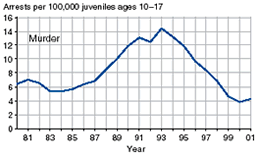
|
Murder
- The juvenile arrest rate for murder peaked in 1993. In that
year, there were about 3,800 arrests of persons under age 18
for murder.
- Between the mid-1980s and 1993, the juvenile arrest rate for
murder more than doubled.
- Between 1993 and 2001, the juvenile arrest rate for murder fell
70%, resting at a level lower than any experienced in the
1980s and 1990s.
|
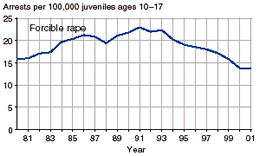
|
Forcible Rape
- The juvenile arrest rate for forcible rape did not vary as much
as the rates for the other violent crimes over the period of
1980 to 2001, although it did follow the general pattern of
growth and decline over the period.
- The juvenile arrest rate for forcible rape increased 44%
between 1980 and 1991 and then fell; by 2001, it was 13%
below the 1980 rate, at its lowest level in at least two decades.
|
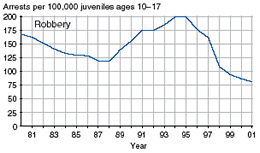 |
Robbery
- The juvenile arrest rate for robbery declined during much of
the 1980s, falling 30% between 1980 and 1988.
- The juvenile arrest rate for robbery increased 70% between
the low year of 1988 and the peak years of 1994 and 1995, to
a level 19% above the 1980 rate.
- Between the peak years and 2001, the juvenile arrest rate for
robbery declined substantially (59%), falling to its lowest level
in two decades.
|
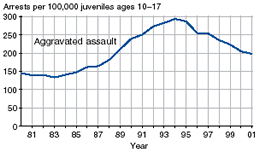
|
Aggravated Assault
- The juvenile arrest rate for aggravated assault doubled
between 1980 and 1994. Its increase between the mid-1980s
and the mid-1990s generally paralleled the increases for murder
and robbery.
- Unlike the juvenile arrest rate trends for murder and robbery,
however, the decline in the juvenile arrest rate for aggravated
assault between 1994 and 2001 did not erase the increase
that began in the mid-1980s. Although the juvenile arrest rate
for aggravated assault fell 33% between 1994 and 2001, the
2001 rate was still 37% above the 1980 level.
|
| Data source: Analysis of arrest data from the FBI and population data from the U.S. Bureau of the Census. [See data source note for detail.]
|
|
Juvenile arrest rate trends for the four Property Crime Index offenses show very different patterns over the
1980�2001 period
|
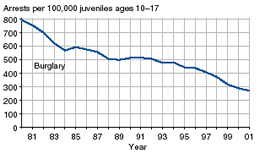
|
Burglary
- Unlike the juvenile arrest rates for any of the other Index
offenses, the rate for burglary declined consistently and substantially
between 1980 and 2001. Over this period, the burglary
arrest rate was cut by two-thirds (66%).
- In 1980, there were an estimated 230,500 juvenile arrests for
burglary; by 2001, this figure had fallen to 90,300.
- Between 1992 and 2001, the number of arrests for burglary
declined substantially for both juveniles and adults (40% and
29%, respectively).
|

|
Larceny-Theft
- The relatively large volume of larceny-theft arrests ensures
that the Property Crime Index arrest trends will reflect the
larceny-theft trends. Therefore, it should be recognized that the
juvenile Property Crime Index arrest trends may not (and in
the 1980–2001 period did not) reflect the juvenile arrest trends
for the other crimes in the Index.
- The juvenile arrest rate for larceny-theft remained relatively
constant between 1980 and 1997, then fell by one-third (34%)
in the brief period between 1997 and 2001.
|
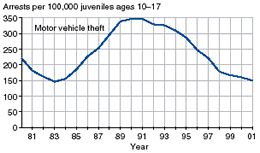
|
Motor Vehicle Theft
- After falling between 1980 and 1983, the juvenile arrest rate for
motor vehicle theft soared, increasing 138% between 1983 and
1990.
- After the 1990 peak, the juvenile arrest rate for motor vehicle
theft declined both consistently and substantially, so that by
2001 the rate was just 3% above its lowest level of 1983 and
57% below its 1990 peak.
- Between 1992 and 2001, the number of arrests for motor vehicle
theft declined 51% for juveniles and 13% for adults.
|
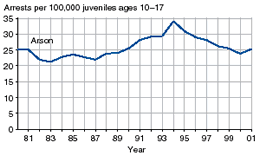
|
Arson
- After being relatively stable for most of the 1980s, the juvenile
arson arrest rate grew 55% between 1987 and 1994. The rate
then declined each year between 1994 and 2000, falling 30%
from the 1994 peak. Between 2000 and 2001, the rate
increased slightly.
- With the exception of running away from home and curfew and
loitering law violations (crimes for which only juveniles can be
arrested), arson is the offense with the greatest proportion of
juvenile arrests. In the 1980s, an annual average of 40% of all
arson arrests involved juveniles; between 1990 and 2001, the
annual average was 50%.
|
| Data source: Analysis of arrest data from the FBI and population data from the U.S. Bureau of the Census. [See data source note for detail.]
|
|
|
|
| Juvenile Arrests 2001 |
OJJDP Bulletin • December 2003 |
|







